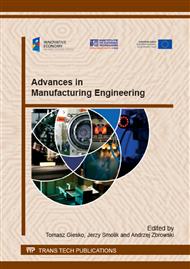p.308
p.316
p.325
p.333
p.340
p.348
p.355
p.362
p.374
Materials Diagnostics: Non-Destructive Identification of Degraded Areas of Microstructure
Abstract:
The influence of material anisotropy on the exploitation performance of structural elements is recognized still insufficiently. The state seems to be the more evident if we consider that each type of materials inhomogeneity is not neutral in relation to its properties. In this field, carefully selected characteristics – the kind of microstructure diagnostics – delivers valuable data for the identification and quantification of desired material parameters deciding its usability. A separate problem is a spatial distribution of the parameters, which is an important feature of advanced, multi-functional materials with gradient-or/and layered structure. Further stages of the microstructure diagnostics covering the prediction of material behaviour in exploitation conditions and the estimation of the time of safe exploitation are still challenging research problems.The enumerated aspects of materials diagnostics require experimental data registered for the representative sample and suitable methods of data processing. Laboratory techniques and modelling procedures utilized in contemporary materials engineering deliver a wide range of computer-aided methodology, enabling one to obtain valuable characteristics of material, including crystallographic texture, residual stresses, phase composition, and crystallite size. In addition to methodological, experimental conditions play an important role in the outlined microstructure diagnostics. Both aspects are evident in the case of the identification of a subtle field of stresses resisted in the near-surface layer or in coating-substrate interface where a non-destructive way of examination is demanded. This work presents a selected non-destructive investigation of degraded areas of materials, recognized as critical from the viewpoint of the behaviour of a specific structural element in exploitation conditions.
Info:
Periodical:
Pages:
348-354
Citation:
Online since:
November 2014
Authors:
Keywords:
Price:
Сopyright:
© 2015 Trans Tech Publications Ltd. All Rights Reserved
Share:
Citation:


